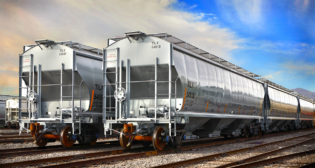
Freight car forecast: 62,300 units in 2014
Written by William C. Vantuono, Editor-in-ChiefLooking further down the road, EPA said annual railcar assemblies will expand very moderately, at historically high levels, from 60,800 cars and intermodal platforms in 2016 to 62,500 in 2019.
“As anticipated in our last report, demand for railcars continues to broaden. In the first quarter of this year, total railcar orders amounted to 24,050 units, 61.8% higher than the fourth quarter of last year,” EPA said. “With assemblies of 13,954 cars, backlogs expanded from 72,937 at the beginning of the year to 81,927 cars at the end of March. This level of backlogs ensures a healthy level of assemblies both this year and next. In fact, our analyses of each car type indicate steady and/or stable growth out to 2019.
“While tank cars remain dominant in the freight car environment, we are enthused by the strong recent growth in demand for mid-sized and small-cube covered hoppers as well as the high level of backlogs for hi-cube equipment. The 11,565 small-cube hopper cars ordered in the opening quarter for frac sand and construction markets has boosted our outlook for this equipment. By the same token, the rebound in grain haulings and the need for dry fertilizers have also boosted our outlook for mid-sized equipment. A rebound of sorts has begun in the area of intermodal equipment, which should continue longer term. We remain cautious on the pickup in demand for coal carrying equipment, but given what appears to be a somewhat more favorable environment, we will closely monitor coal demand this year and next.
“Demand for tank cars remains steady, as railroads and shippers decide on whether to retrofit the 78,000 DOT 111 cars currently in the fleet or purchase new equipment. Industry sources have specified that retrofitting the entire DOT 111 car fleet would involve an investment of over $3 billion. Rail operators, oil producers, and tank car manufactures have for months failed to agree on the best model to serve the fast growing domestic oil sector. Of particular concern is North Dakota’s Bakken region, where oil production is nearing one million barrels per day and roughly 72% of that fuel moves on the tracks because of a shortage in pipelines. A tougher tank car design known as the CPC-1232 has been the industry standard since 2011, with many of those cars rolling out of factories in recent years to meet oil by rail demand. Delivery of oil by train has rocketed as the Keystone XL pipeline has been delayed for four years.
“It’s important to note that’s far from the only reason the transportation method for oil has boomed, as it also coincides with a boom in production here in the U.S., notably from the Bakken Formation in North Dakota. According to the data from the Association of American Railroads, U.S. carloads of petroleum products have more than doubled since April 2010, the first time the State Department delayed Keystone approval. There are advantages to carrying oil and other petroleum products by rail, since that method allows connections to any destination with railways, as opposed to the fixed points available on pipelines.
“Even with a strong 8,451 assemblies in this year’s opening quarter, backlogs of 50,489 tank cars represent about six quarters of deliveries at current rates. Due to the rapid expansion in oil production and the lack of any significant pipeline additions, rail will continue to benefit and we anticipate strong annual deliveries of oil service tank cars throughout the forecast horizon. Given the ongoing strength in demand for oil tank cars, we are maintaining our short-term deliveries estimates. With railroads espousing the growth of petroleum movements, the possibility of overhauling a major portion of the fleet with newer equipment, and industry reports of expanding productive capacity among the car builders, we expect 2014 deliveries of 33,000 tank cars. By the same token, our 2015 estimate of assemblies is a healthy 29,000 cars.
“With regard to other car types, we continue to be concerned about the underwhelming growth of the economy as manufacturers, oil and gas producers, and coal companies struggle with the increasing number of government regulations that are dampening our economic potential. Hopefully, our economy can eventually embark on a stronger path of growth that will improve railroad traffic, revenue, and investments, leading to continued healthy growth in railcar demand.
“From this point on, we look for steady demand for boxcars, grain cars, small-cube covered hoppers, and mill gondolas, and continued strong tank car demand. Even with an anticipated rebound in coal hauling this year, we remain cautious on the outlook for coal cars, primarily because we have heard that customers prefer to rebuild rather than purchase new equipment in the currently dismal coal environment.
“With a rebound in agricultural products and coal, the Class I’s reported good revenues and profits in the first quarter. The roads also continue to make investments in track, facilities, and equipment. The solid income base of the railroads should serve to support railcar demand in the years to come. Also, the roads are indicating strong capital spending plans for 2014 as they prepare for continued growth in oil, chemical, light vehicle, and intermodal movements. And, the investments will be well founded as we witness future growth in these categories.
“Light vehicle sales have succumbed to harsh weather thus far in 2014. After averaging 15.62 million units (seasonally adjusted annual rate) in the second half of last year, January’s rate of sales dropped to 15.16 million units, followed by a very modest rebound to 15.28 million units in February. However, auto sales rebounded strongly in March to an annual sales rate of 16.33 million units as sales of light trucks rose to the highest level since mid- to late-2007. While we are factoring in an improvement in sales due to warmer weather in the months ahead, we continue to remain leery on the future course of auto sales through the next two years.
“Until the economy is on more solid footing, employment advances at a more significant pace, and consumer income growth increases, we expect quarterly auto sales to remain relatively flat at high levels during 2014 and 2015. After a 7.3% advance in auto sales to 15.49 million units last year, we expect far more modest growth to 15.78 million vehicles in 2014 and 16.43 million units in 2015. According to Ward’s Automotive Group, North American light vehicle production amounted to 4.27 million vehicles, 4.4% above the comparable period of 2013. U.S. production was up 5.3% and Mexican output expanded 6.7%, while Canadian production was off 3.0%. Based on our outlook for the U.S. economy and consumer demand for light vehicles, we expect modest North American production increases this year and next.
“From this point on, we continue to look for only moderate quarterly advances in manufacturing through 2014 and into 2015. Consumer spending will be sluggish, the job markets are weak, confidence has weakened, and consumers are looking to improve their balance sheets, rather than purchase more products. Due to resurgences in foreign economic activities, our exports will advance 4.3% in 2014 and 4.5% in 2015. By the same token, somewhat stronger domestic activities should lead to a 2.9% gain in imports in 2014, followed by a 4.2% advance in 2015. Under these circumstances, we look for moderate quarterly gains in factory output over the next two years. After a 2.5% increase in 2013, we expect manufacturing activities to advance 2.1% in 2014 and 2.6% in 2015.
“Thus far in 2014, domestic steel shipments through February were running 0.9% below the 2013 level. Steel imports through March were 15.0% above the comparable period of 2013. As anticipated, exports of corn, wheat, and soybeans picked up in the fourth quarter of last year and have continued to expand in the first quarter of this year. More important, the USDA anticipates further gains in our crop exports this year, which should boost grain movements. Based on increased production, consumption, and exports, we expect a rebound in grain haulings this year and next. After an 8.0% drop last year, we expect grain haulings to increase 8.0% this year and 2.4% in 2015.
“Longer term, we are hopeful that stronger economic activities will provide support for certain railcar assemblies while an improvement in the financial environment, high gasoline prices, and strong government backing stimulate greater demand for ethanol and DDG cars. Replacement pressures and technological advances as well as legislative measures will also play a role in promoting the demand for a variety of railcars. Construction activities are expected to continue to advance, which should support movements of aggregates and structural steel products. Continued expansion in demand for crude oil, petroleum products, chemicals, and food and beverages will prop up haulings of a variety of liquid products and the demand for tank cars. Growing worldwide nutritional needs and expanding exports will pressure the current grain service cars as we proceed through the longer term while long neglected segments such as equipment to haul waste, aggregates, and limestone show signs of revival and should add to the railcar delivery mix in the years to come. However, the most dynamic element in the long-term railcar environment will be tank cars to transport ever increasing volumes of oil and petroleum products.”



